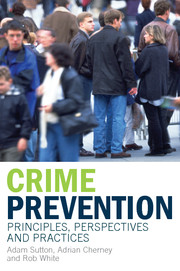6 - From research to policy
from PART 2 - PRACTICE
Summary
Introduction
This chapter will discuss the following topics:
France;
the Netherlands;
the UK;
Australia; and
the way forward.
Contemporary politicians and other policy makers talk about the ‘rediscovery’ of crime prevention. Such language is misleading. As Chapters 2, 3 and 4 have shown, crime prevention has been around for a very long time. Concepts and principles of social and environmental prevention do not need to be rediscovered or reinvented. Like tool-making and speech, they are capacities that all humans can exercise, given the right conditions.
If anyone has forgotten about crime prevention, it is politicians and policy makers. To maintain and enhance their legitimacy, parties and their leaders need to be seen playing direct roles in protecting the public. Crime prevention, however, often works best when it is not so obvious: when it is subtly embedded in everyday routines and activities. Families, preschools, schools, sports clubs and vocational training centres all can contribute to the reduction of offending. However, they also do much more than this, and attaching the prevention label to their work can be counterproductive (see Chapter 3). Major prevention benefits also can flow from sound urban planning and environmental design, and from appropriate management of shopping centres, entertainment centres, malls and other facilities (Chapters 2 and 7). Again, there is no need for relevant practices always to carry the crime prevention label. Overemphasis on target hardening and other conspicuous security measures can merely intensify fear.
- Type
- Chapter
- Information
- Crime PreventionPrinciples, Perspectives and Practices, pp. 93 - 113Publisher: Cambridge University PressPrint publication year: 2008



